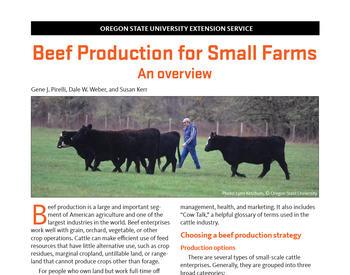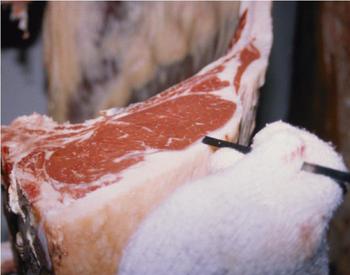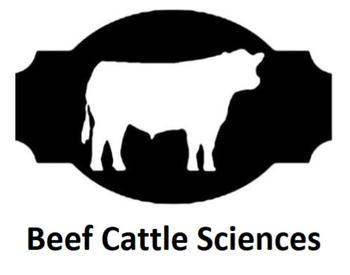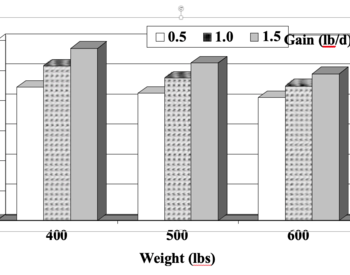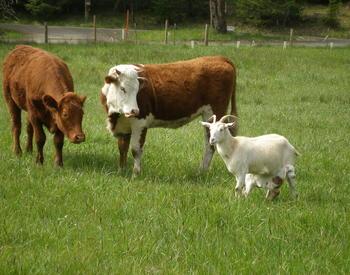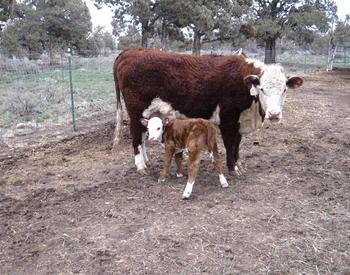Introduction
Artificial insemination (AI) has been utilized by the cow-calf industry for over 50 years. The advances in techniques to freeze semen allowed producers to infuse new and improved genetic material into their herd without the expenses of purchasing and maintaining high-merit and proven (high accuracy) bulls.
Recent development of estrus synchronization and fixed-time AI protocols allowed producers to breed more cows in a much shorter period of time and enhance the overall reproductive performance of the cowherd. Another advantage of AI protocols is that beef producers can assess and record the reproductive performance of individual cows. With individual records, producers have the chance to refine the reproductive ability of the herd and increase the efficiency of the operation, given that reproductive failure is one of the major sources of economic losses within a cow-calf system.
This article will further address some of the advantages and disadvantages of AI and review the most common estrus synchronization protocols that are currently available to producers.
Learning AI
The success of an AI program highly depends on the skills of the AI technician. Without proper training, AI equipment and semen can be seriously damaged. Training is also important to minimize hazards to the cow and the technician. Typically, semen companies can provide or recommend well-trained technicians to producers who purchase their products.
Producers and farm crews also have the option to attend AI schools and learn the required techniques. For further information about these courses, please contact your county agent or the National Association of Animal Breeders, an entity that recommends the minimum standards for AI schools.
Advantages of estrus synchronization + AI
Including estrus synchronization and AI in the breeding program brings several benefits to producers. Some of these benefits are:
- Breeding and calving seasons can be shortened and better characterized.
- Hastened infusion of new and improved genetic material into the herd. Selecting sires that are genetically tested and classified for desired EPDs will generate a superior and more efficient calf crop.
- Improved reproductive records of the cowherd. Producers will have a better idea of the reproductive ability of each individual cow.
- If heat detection is included in the AI program, producers will also have a better idea of the cycling status of the cowherd during the breeding season.
- Better control of venereal diseases such as vibriosis and trichomoniasis.
- Ability to select specific sires with desired EPDs for different animal groups, such as replacement heifers and mature cows.
- Decrease the number of bulls in the operations, which brings not only economic savings but also management and safety benefits. As a rule of thumb, a proportion of 1 bull for 25 non-pregnant cows should be used. If 200 cows are exposed to the AI program, and 50% of them become pregnant to AI, 100 cows remain open; therefore 4 clean-up bulls should be used. If producers want to identify the calves’ sire, a 15-day interval between AI and bull exposure should be included; therefore a similar interval will be observed during the calving season, which will allow producers to determine the calf’s sire. Another option is to AI and subsequently expose cows to bulls with different phenotypes, such as Angus and Charolais bulls.
Challenges of estrus synchronization + AI
As with any other management decision, synchronization and AI also brings challenges to producers. However, these are commonly compensated by the advantages previously described. Some of the challenges of AI programs are:
- Requires careful planning well in advance to the beginning of the program.
- Requires additional management and handling of cows. Typically, cows need to be processed three times within a 10-day interval.
- Requires trained personnel and intensive labor.
- Requires special handling facilities.
- Requires special equipment, such as AI tools, semen tank and liquid nitrogen.
- Calving will occur in a narrow window, which can increase concerns with inclement weather and possible disease challenges during the calving season.
- Costs associated with drugs and semen.
Synchronization of estrus and fixed-time AI
Estrus synchronization consists of grouping heat and/or ovulation of the herd into a short period of time, which typically ranges within five days, so AI the breeding can be concentrated. Specific products are required for estrus synchronization, and they vary according to the protocol adopted.
Hormones commonly used in estrus synchronization:
- GnRH (Trade names: Cystorelin®, Factrel®, Fertagyl®, OvaCyst®).
- Progestins (Trade names: CIDR®, MGA®).
- Prostaglandin (Trade names: Lutalyse®, Estrumate®, ProstaMate®, estroPLAN™, In-synch™).
There are several estrus synchronization + AI programs currently available to producers, and these can be divided into three main categories:
- Heat detection and AI: During and following the estrus synchronization protocol, cows will come into heat during a specific time frame depending on the protocol utilized. The technician will need to determine the time that each cow begins showing standing heat and then AI the cow approximately 12 hours later.
- Fixed-time AI: Following the estrus synchronization protocol, all cows are inseminated at a predetermined time; therefore heat detection is not necessary.
- Heat detection + fixed-time AI: During and following the estrus synchronization protocol, cows that come into heat are inseminated 12 hours later. All cows not detected in heat are inseminated at a predetermined time.
Within these three categories, there are many alternatives that producers can choose from. Under adequate management conditions, the protocols currently available can yield pregnancy rates to AI between 45% to 60%, whereas recently developed protocols are producing pregnancy rates around 70%. Nevertheless, the success of estrus synchronization + AI programs will depend on the producer and operation system. Therefore, producers should not select protocols for the pregnancy rates that they can yield under “optimal conditions” but should choose protocols that will fit into their management scheme.
Protocols for estrus synchronization + AI
In this publication, we will only describe protocols that have been thoroughly tested by research studies and are recommended by the Beef Reproductive Task Force, which is a group of specialists in beef cattle reproduction (See appendix 1). These protocols yielded different pregnancy rates when evaluated under adequate management conditions (Table 2), which means that cows were in adequate nutrition, trained labor and facilities were available, and a substantial number of animals were utilized. But before selecting a specific protocol, producers should consider some of the following factors:
- Cost efficiency: Estrus synchronization programs are not always profitable. Producers should first determine the costs required for implementing the selected protocol, such as hormones, semen, and labor costs, and compare that to the expected outcomes, such as pregnancy rates, calving distribution and performance of the offspring.
- Herd size: Heat detection can be impaired in a large group of cows. Also, dividing the herd into several smaller groups can decrease the efficiency of heat detection. Therefore, fixed-time AI might be the most adequate approach when breeding large herds.
- Body condition score: Cows in low body condition score following calving are likely not cycling and therefore might not respond well to the synchronization + AI protocol. If no other alternatives are available, assigning thin noncyclic cows to a synchronization protocol that contains CIDR, MGA or GnRH might be an alternative to induce cyclicity. Nevertheless, cows with low body condition score (less than 4) typically have reduced pregnancy rates to AI compared to cows in adequate body condition (5 or 6).
- Animal category: Mature cows and replacement heifers respond differently to estrus synchronization protocols because their reproductive physiology differ. Therefore, specific protocols were developed for each category (Figure 1). Assigning heifers to protocols developed for mature cows, or vice versa, may result in decreased pregnancy rates.
- Availability of labor and facilities: Producers should select the protocol that matches the labor force and handling facilities of the operation. Remember, the estrus synchronization + AI protocols that result in the highest pregnancy rates also require cows to be handled several times.
- Semen source: Producers who will breed cows with valuable semen, which is common in seedstock scenarios, should choose protocols that utilize heat detection. Even though labor is increased and fewer cows are inseminated in a short period of time, AI following heat detection generally yields greater pregnancy rates compared to fixed-time AI, resulting in better utilization of the semen. Further, if valuable semen is selected, a greater investment has been made. Every effort should be made to achieve greater pregnancy rates, including having a high percentage of females cycling at the start of the breeding season by using a quality nutrition program and an adequate number days since last calving.
| Protocol | Relative cost | Labor required | Animals evaluated | Avg. pregnancy rates, % |
|---|---|---|---|---|
| Heat Detection and AI | ||||
| Select Synch | Low | Medium/High | 678 cows | 46 |
| Select Synch + CIDR® | High | Medium | 595 cows | 51 |
| MGA® – PG | Low | Low/Medium | 2,746 heifers | 60 |
| Fixed-time AI | ||||
| 7-day Co-Synch + CIDR® | High | Medium | 8,124 cows | 59 |
| 5-day Co-Synch + CIDR® | High | Medium | 1,162 cows | 68 |
| Co-Synch + CIDR® | High | Medium | 1,389 heifers | 49 |
| MGA® – PG | Medium | Medium | 831 heifers | 46 |
| CIDR® Select | High | Medium/High | 1228 heifers | 62 |
| Heat Detection and Fixed-time AI | ||||
| MGA® – PG | Medium | Medium | 1,905 heifers | 56 |
| Select Synch | Low | Medium/High | 2,048 cows | 51 |
| Select Synch + CIDR® | High | Medium | 1,596 cows | 56 |
| 748 heifers | 56 | |||
Conclusion
Artificial insemination is an important tool to infuse new and improved genetics into the herd. Recent advances in estrus synchronization protocols and fixed-time AI techniques increased the number of cows that can be bred during a shorter period of time.
Several estrus synchronization + AI protocols were developed, tested, and are currently available to producers; however, producers should select the protocol that is cost-efficient and matches their operating system, such as type and condition of cattle, labor availability and handling facilities.
For additional information regarding the protocols and techniques described herein, please visit the CowCalf Guide and the Beef Reproductive Task Force website.
References
- Beef Reproductive Task Force. 2009. Protocols for synchronization of estrus and ovulation.
- Bridges et al., 2008. Purdue University Cooperative Extension Service, AS-575-W.
- Colburn, D. 2008. In: Cow-Calf Management Guide, CL405.
- Stenquist, N. J., and T. Geary. 2008. In: Cow-Calf Management Guide, CL404
- Estrus Synchronization Protocols
This document is part of the Oregon State University – Beef Cattle Library. Prior to acceptance, this document was anonymously reviewed by two experts in the area.

